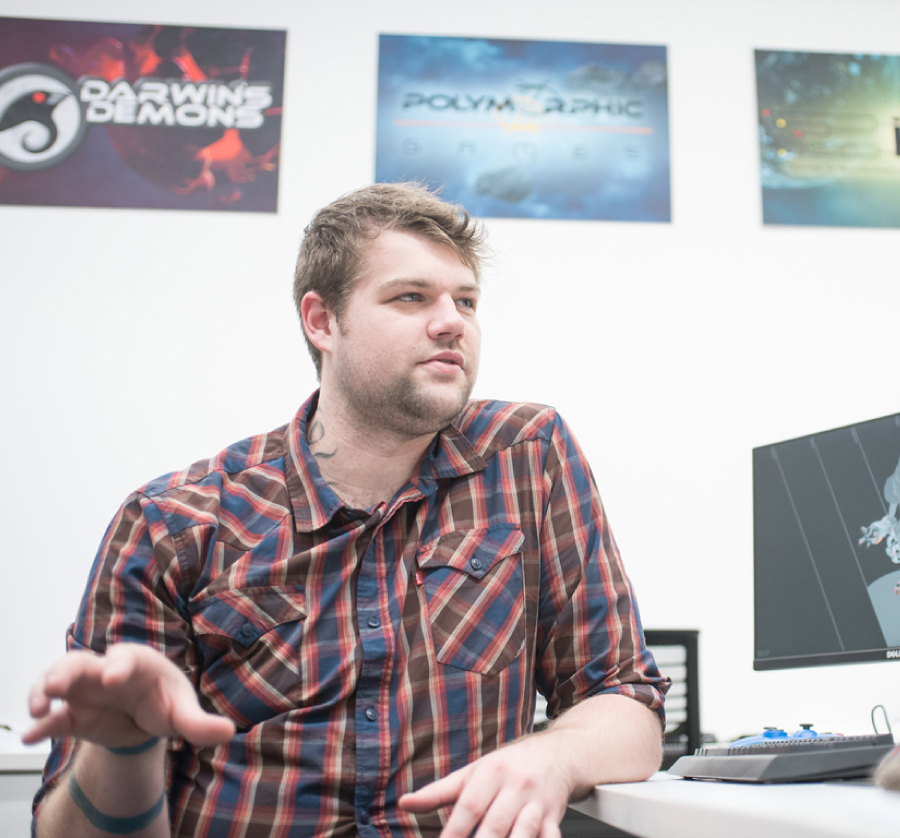
Cameron Perry: Animating a Hero
At age 6, Cameron Perry began playing a video game that featured a world undergoing industrialization. The consequences were environmental degradation and the exploitation of labor. Perry didn’t understand the themes at the time. He was more concerned with helping his character escape a meat packing plant and join a band of revolutionaries. Over time, the game’s motif started to sink in. “There’s plenty of issues in fiction where you have a prominent social issue and it’s an analog for what’s going on in the real world,†said Perry, a virtual technology and design student graduating in fall 2018 from the University of Idaho College of Art and Architecture. “Abstracting things like that lets us examine social issues that might otherwise be uncomfortable.†Perry worked for Polymorphic Games at U of I and created animations for Project Hastur, a video game where users try to protect humanity from invading aliens that evolve in response to users’ defenses. He also worked for the university’s Institute for Bioinformatics and Evolutionary Studies, designing a mobile app prototype to teach kids about snail biology, evolution and conservation. A native of Boise and Bonners Ferry, Perry, 26, already has a job lined up creating virtual reality environments as a more engaging and less costly aid for workplace training. Someday, though, Perry would like to return to the realm of video games, creating “oppressive worlds that people are fighting back against.â€
U of I Study Predicts Increase in Global List of Threatened Plant Species
MOSCOW, Idaho — Dec. 3, 2018 — More than 15,000 plant species have a high probability of being considered threatened or near-threatened under a new model used to predict conservation status. The model, which shows the predicted levels of risk to plants worldwide, was published as part of a study to help governments and resource managers evaluate where conservation resources are most needed. Findings from the model, built by a research team from the University of Idaho, University of Maryland, Radford University and The Ohio State University, were published today in the Proceedings of the National Academy of Sciences. The International Union for Conservation of Nature’s (IUCN) Red List of Threatened Species is a powerful tool for researchers and policymakers working to limit species loss across the globe. A new approach developed at U of I and The Ohio State University uses the power of machine learning and open-access data to predict plant species that could be eligible for at-risk status on the IUCN Red List. Adding even a single species to IUCN’s Red List demands hours of expensive, rigorous and highly specialized research. As a result, many known species have not been formally assessed by the IUCN and ranked from least concern to critically endangered; only about 5 percent of all currently known plant species appear on IUCN’s Red List in any capacity. The research team created and trained a machine learning algorithm to assess more than 150,000 species of plants from all corners of the world, making their project among the largest assessments of conservation risk to date. The researchers trained the model using open-access data from the relatively small group of plant species already on the IUCN Red List, and then applied the model to the many thousands of plant species that remain unlisted by IUCN. “Our method isn’t meant to replace formal assessments using IUCN protocols. It’s a tool that can help prioritize the process, by calculating the probability that a given species is at risk,†said Anahà EspÃndola, who worked on the project as a U of I postdoctoral researcher and now is an assistant professor at the University of Maryland. “Ultimately, we hope it will help governments and resource managers decide where to devote their limited resources for conservation. This could be especially useful in regions that are understudied.†The model predicted roughly 10 percent of the total plants assessed by the team have a high probability of qualifying as near-threatened or worse. Maps of the data indicate at-risk species tend to cluster in areas already known for their high native biodiversity, such as the Central American rainforests and southwestern Australia. The model also flagged regions such as California and the Southeastern United States, which are home to a large number of endemic species not naturally occurring anywhere else on Earth. “Although our primary goal was to help prioritize the process for ranking species, identifying geographic areas with high concentrations of potentially at-risk species was an added bonus,†said David Tank, associate professor in U of I’s Department of Biological Sciences. The model also flagged a few surprising areas not typically known for their biodiversity, such as the southern coast of the Arabian Peninsula, as having a high number of at-risk species, according to the study. Some of the most imperiled regions have not received enough attention from researchers, EspÃndola said. She hopes the study method can help to fill in some of these knowledge gaps by identifying regions and species in need of further study. “We’re in an era in which large-scale public databases contain massive amounts of information,†said Jack Sullivan, a professor in U of I’s Department of Biological Sciences. “This paper demonstrates that machine learning approaches can yield important conclusions in biodiversity studies by detecting signals and patterns in big data.†Media note: An image associated with the study’s findings is attached to the press release. Image caption: This map shows the predicted levels of risk to more than 150,000 species of plants located worldwide. Warmer colors denote areas with larger numbers of potentially at-risk species, while cooler colors denote areas with low overall predicted risk. Image credit: Anahà EspÃndola and Tara Pelletier. This project was funded under National Science Foundation grant No. DEB-1457726. The total amount of federal funds for the project is $622,609 of which 100 percent is the federal share.

Polymorphic Games' Sam Heck to Present the Studio's Upcoming Title Project Hastur at AIIDE 2018
Samantha Heck, a senior in Computer Science and the lead programmer for Polymorphic Games, will present Project Hastur as a playable experience at this year’s Artificial Intelligence and Interactive Digital Entertainment conference, or AIIDE 2018. AIIDE serves as the definitive point of interaction between entertainment software developers interested in artificial intelligence and academic AI researchers. This year’s conference will be held at the University of Alberta in Edmonton from November 13-17. Project Hastur is a tower defense style game that features a unique approach to Artificial Intelligence (AI). The in-game enemies in Project Hastur are modeled as an evolving population with digital genomes. These enemies, called Proteans, evolve in response to how the player plays. For example, if the player has a penchant for flame-based weaponry, future generations of Proteans will evolve traits that confer fire resistance. This AI system is a form of procedural enemy generation in which the game adapts to the player, increasing replay value. “Project Hastur stands out at AIIDE because it’s built as a commercial game that’s fun to play.†Heck says. “Most projects in the Playable Experience track of AIIDE are smaller and focus on research rather than on the game play experience.†Alongside a playable demo, Heck will present Project Hastur during a poster session and a Q&A panel where she will answer questions from conference attendees.

IBEST Computational Resources Core Installs Major Upgrades to Research Computing Infrastructure
The Institute for Bioinformatics & Evolutionary Studies’ (IBEST) Computational Resources Core recently installed significant server upgrades. These upgrades include 160 new processor cores and an additional 768 GB of RAM. Early benchmarking indicates this hardware will increase processing speeds by nearly 300%. This speed increase is critical in meeting the evolving computational needs of University of Idaho researchers. For example, cost reductions in genome sequencing technologies have resulted in the production of extremely large data sets. Analyses of these data sets can take days or weeks, making a 300% speed increase a significant advantage for UI researchers. The number of clients of the CRC has tripled in the past three years, further underscoring the need for investments in UI research computing infrastructure. The IBEST CRC supports the research computing needs of a very diverse community of researchers from 19 departments across 5 colleges. Researchers from elsewhere in the country also use the CRC. For example, researchers from Reed College in Portland, OR are already using the new equipment to study how rates of mutation vary across and within natural populations of Daphnia, small aquatic crustaceans commonly called water fleas. The $23,591 in server upgrades were funded in part by an Office of Research and Economic Development (ORED), Equipment and Infrastructure Support Award. These awards enhance research at the University of Idaho by supporting equipment purchases, upgrades and repairs related to research and creative activity infrastructure. Researchers interested in learning more about the computing and data storage services of the CRC should contact Dr. Benjamin Oswald at Ibest-CRC@uidaho.edu.

BCB Student Sarah Hendricks' Research Featured on NPR
U of I Bioinformatics and Computational Biology (BCB) student Sarah A. Hendricks' research on Northwest wolf populations was recently featured by Northwest Public Broadcasting (NWPB), the regional NPR station based in Pullman. The article details Hendricks' findings, recently published on Nature.com, that modern Northwest wolf populations descended from two distinct groups – one from the northern Rocky Mountains and one from coastal rain forests along Canada's west coast and southeast Alaska. According to Hendricks, these findings could be significant when it comes to legislation surrounding species with mixed ancestry, especially if one entity is a member of the Endangered Species List. "We are currently lacking legal terminology dealing with admixed populations,†she said. “This case example shows why it's important to add specific language to properly manage them.†Photo Credit: Chris Darimont

BCB Student Featured on NPR
U of I Bioinformatics and Computational Biology (BCB) student Sarah A. Hendricks' research on Northwest wolf populations was recently featured by Northwest Public Broadcasting (NWPB), the regional NPR station based in Pullman. The article details Hendricks' findings, recently published on Nature.com, that modern Northwest wolf populations descended from two distinct groups – one from the northern Rocky Mountains and one from coastal rain forests along Canada's west coast and southeast Alaska. According to Hendricks, these findings could be significant when it comes to legislation surrounding species with mixed ancestry, especially if one entity is a member of the Endangered Species List. "We are currently lacking legal terminology dealing with admixed populations,†she said. “This case example shows why it's important to add specific language to properly manage them.â€
CRC Hardware Upgrades
The Institute for Bioinformatics & Evolutionary Studies (IBEST) Computational Resources Core recently installed significant server upgrades. These upgrades include 160 new processor cores and an additional 768 GB of RAM. Early benchmarking indicates this hardware will increase processing speeds by nearly 300%. This speed increase is critical in meeting the evolving computational needs of University of Idaho researchers. For example, cost reductions in genome sequencing technologies have resulted in the production of extremely large data sets. Analyses of these data sets can take days or weeks, making a 300% speed increase a significant advantage for UI researchers. The number of clients of the CRC has tripled in the past three years, further underscoring the need for investments in UI research computing infrastructure. The IBEST CRC supports the research computing needs of a very diverse community of researchers from 19 departments across 5 colleges. Researchers from elsewhere in the country also use the CRC. For example, researchers from Reed College in Portland, OR are already using the new equipment to study how rates of mutation vary across and within natural populations of Daphnia, small aquatic crustaceans commonly called water fleas. The $23,591 in server upgrades were funded in part by an Office of Research and Economic Development (ORED), Equipment and Infrastructure Support Award. These awards enhance research at the University of Idaho by supporting equipment purchases, upgrades and repairs related to research and creative activity infrastructure. Researchers interested in learning more about the computing and data storage services of the CRC should contact Dr. Benjamin Oswald at Ibest-CRC@uidaho.edu.
BEACON Grants Secured
University of Idaho faculty members in the Institute for Bioinformatics and Evolutionary STudies (IBEST) have been awarded $346,969 this year in new competitive grants as part of the National Science Foundation BEACON Science and Technology Center on "Evolution in Action". These funds support nine projects involving eight UI faculty members, along with graduate
Data Science Competition
U of I Launches Student Data Science Competition through April 22 March 13, 2018 The College of Science, Department of Mathematics and IBEST are sponsoring the first-ever University of Idaho Student Data Science Competition. The competition is open from March 12 through April 22. The goal is to promote Data Science research and education on campus. There are two tracks to the competition:
